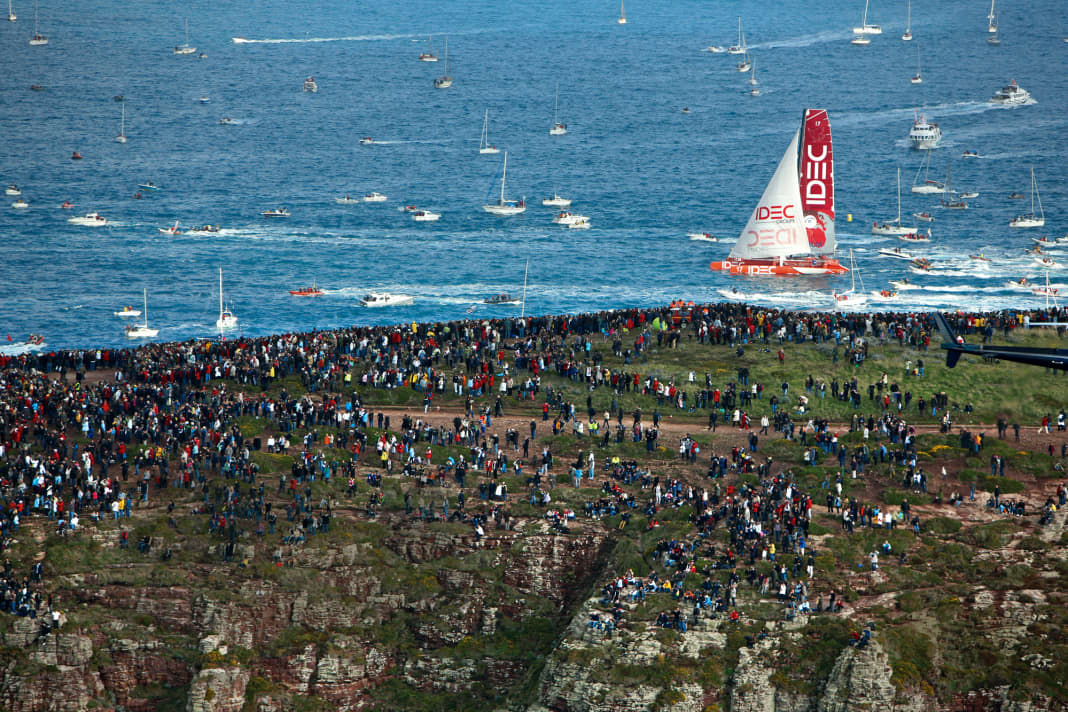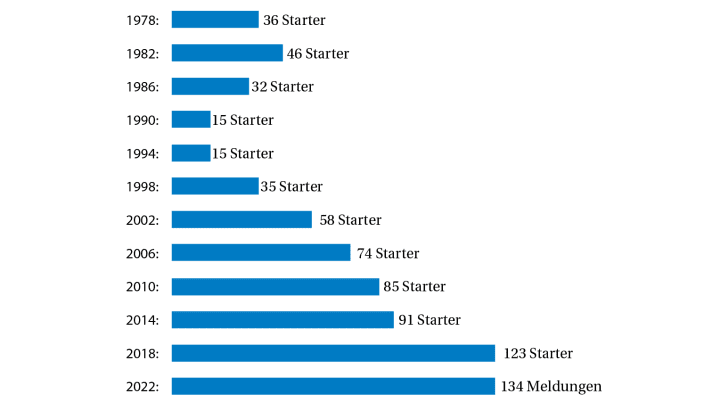Route du Rhum: Single-handed across the Atlantic, view of the spectacle on Sunday
Tatjana Pokorny
· 02.11.2022






It is a magical race in the stern waters of great champions that inspires young and old alike and brings together so many different classes and sailors like no other"
The declaration of love by Frenchman Yannick Bestaven, reigning Vendée Globe winner, is a good expression of why the race is considered the queen of transatlantic regattas. The 3,542 nautical mile course takes the challengers from Saint-Malo in Brittany to Pointe-à-Pitre on Guadeloupe, in other words from the European winter to the Caribbean summer. 44 years after the premiere, a record field has registered for the start.
134 soloists, a record for the Route du Rhum
When the Route du Rhum sets sail on 6 November, 134 soloists will motor through the lock of the tidal harbour, the first of them at dawn, cheered on by tens of thousands of onlookers who don't want to miss this ceremony. Meanwhile, other fans park at Cap Fréhel, several kilometres west of the starting harbour, and hike to the cliffs from where they can see the English Channel. A region in a state of emergency, and quite rightly so.

Quite a few of the 128 men and six women competing here are among the elite of the solo scene; several dozen are taking part as dedicated amateurs, including skippers in the two Rhum classes and Class 40. The age structure is broadly diversified, ranging from the 20-year-old Class 40 challenger Martin Louchart from the Norman fishing town of Granville to the 69-year-old Franco-Algerian André Laumet, who experienced the final of the Route du Rhum premiere in 1978, has been sailing for 46 years and is competing in the Rhum Mono class with his 2003 Finot Conq 40 footer "Léa".
The Route du Rhum belongs to the French
The "Rhum", as it is known in France for short, is and remains a national affair. More than 80 per cent of the participants compete under the French flag, with some, like the German-French Isabelle Joschke in the Imoca class, also competing for two nations. However, the long-distance event is attracting a growing number of international participants. The field includes Great Britain, Switzerland, the USA, Italy, Australia, New Zealand, South Africa, Croatia, Belgium, China, Japan, Algeria, Israel and Germany with Boris Herrmann's "Malizia - Seaexplorer". Three skippers come from the archipelago of Guadeloupe, the destination they all want to reach.
Sailing takes place in a total of six racing classes: Class 40, Imoca, Ocean Fifty, Rhum Mono, Rhum Multi and Ultim 32/23. In the latter, the league of maxi-trimarans, true giants come together. Stars such as the former Vendée Globe winners François Gabart ("SVR Lazartigue") and Armel Le Cléac'h ("Maxi Banque Populaire XI"), Thomas Coville ("Sodebo Ultim 3"), Volvo Ocean Race winner Charles Caudrelier ("Maxi Edmond de Rothschild") and three outsiders gather for the ultimate power play on the Atlantic.
The Imoca class will attract at least as much attention. Never before have there been so many Open 60s at the start of the Route du Rhum, including seven new builds and the best boats of the previous generation. Soloists such as Paul Meilhat ("Biotherm"), Benjamin Dutreux ("Guyot Environnement - Water Family") and Kevin Escoffier ("Holcim - PRB") are preparing for the team circumnavigation The Ocean Race, which starts in Alicante on 15 January 2023, in the Transat regatta. This also applies to Boris Herrmann, who will be sailing single-handed for the first time with his team Malizia after the boat christening and a first Défi azimuth race.
The winners of the Route du Rhum
Canadian Mike Birch was the first to enter the list of winners in 1978. He travelled 23 days and almost 7 hours on the trimaran "Olympus Photo". The triumph remains unforgotten because Birch crossed the finish line just 98 seconds ahead of Michel Malinovsky's "Kriter V", which was twice as big. The unequal duel provided the first popularity boost. The Frenchman Alain Colas was lost at the premiere. His death brought out the other, darker side of the race.
After winners such as America's Cup skipper Marc Pajot (1982 with "Elf Aquitaine") and Philippe Poupon (1986 with "Fleury Michon VIII") had left their mark on the Route du Rhum, the Rhum family mourned again in 1986: Loïc Caradec had gone overboard from his 85-foot maxi catamaran "Royale", which capsized in a storm and remained at sea.
Florence Arthaud made international headlines in 1990 with her trimaran "Groupe Pierre 1er". "The little fiancée of the Atlantic", as she was also known, was the first woman to win the Route du Rhum. This earned her fame and respect, as well as countless proposals of marriage from her unknown suitors.
With Laurent Bourgnon on "Primagaz", a Swiss man wrote his name in the winners' lists in 1994. Four years later, he even managed the double with the same boat. With a sailing time of 12 days, 8 hours, 41 minutes and 6 seconds, he almost halved Mike Birch's première performance.
This was followed by the era of "Le Professeur": Michel Desjoyeaux, who also left his mark on the Vendée Globe like no other, won in 2002 with the Orma 60 trimaran "Géant" in one of the toughest races to date. In the Bay of Biscay, the wind was blowing at up to 75 knots at times and many boats were wrecked. Nevertheless, Desjoyeaux was convinced that "this regatta is anchored in the hearts of the French".
There is hardly a big name in the sport who hasn't tried their hand at the Rhum: Lionel Lemonchois won in 2006 with "Gitana 11" in just 7 days, 17 hours, 19 minutes and 6 seconds. Four years later, the star of the ambitious Franck Cammas rose, who later shone in the Volvo Ocean Race and the America's Cup. Cammas won with "Groupama 3" and called the race a "magical test".
With Loïck Peyron, another maestro from the never-ending French source of great sailing skills brilliantly parried all the tests of the classic. On his 49th trip across the Atlantic, he won the tenth anniversary edition as a last-minute replacement for the injured "Banque Populaire" skipper Armel Le Cléac'h in 7 days, 15 hours, 8 minutes and 32 seconds. Afterwards, Peyron described his encounter with a raging Bay of Biscay storm as "frightening at times".
Over the decades, many challengers have faced similarly harsh abysses in the North Atlantic, especially in the early stages of the race. In 2014, severe weather caused a cancellation rate of just under 30 per cent. On the very first night, eleven out of 91 soloists had to retire. In the negative record year of 2002, only around half of the participants reached the finish line.
The records of the Route du Rhum
- Class 4016 days, 3 hours, 22 minutes, 44 seconds (Yoann Richomme/"Veedol")
- Imoca12 days, 11 hours, 23 minutes, 18 seconds (Paul Meilhat/"SMA")
- Rhum Mono16 days, 10 hours, 18 minutes, 5 seconds (Sidney Gavignet/"Café Joyeux")
- Rhum Multi15 days, 21 hours, 15 minutes, 5 seconds Pierre Antoine/"Olmix")
- Multi 50 (now Ocean Fifty): 11 days, 7 hours, 32 minutes, 40 seconds (Armel Tripon/"Réauté Chocolat")
- Ultim7 days, 14 hours, 21 minutes, 47 seconds (Francis Joyon/"Idec Sport")
The current record holder, but not at the start this time, is "Idec Sport" skipper Francis Joyon, who finished the 2018 race as the fastest in the fleet after just 7 days, 14 hours, 21 minutes and 47 seconds. If things go according to plan for the Ultim giants this time, this record is likely to fall, as the new 32-metre maxis are all starting on foils. New best times can also be expected in the Class 40 and the Imocas.
Like the Olympic Games, the Route du Rhum is only held every four years. This increases the covetousness. In the largest group of 53 boats in the Class 40, the best are also fighting for the attention of sponsors and want to make the leap into the larger Imoca class with good performances. The Route du Rhum offers the ideal springboard for this. Co-favourite Yoann Richomme, for example, who won the 2018 race and is now returning with a new Class 40 while he waits for his Imoca for the next Vendée Globe. In addition to Richomme, the current Class 40 greats include Ian Lipinski, Luke Berry, Axel Trehin, Corentin Douguet, Xavier Macaire and the Swiss Simon Koster.
Boris Herrmann took fifth place in the Imoca class at his Rhum premiere in 2018, the best German result in history. Previously, Jörg Riechers had delivered a strong German sailing performance in 2010 with sixth place in the Class 40.

